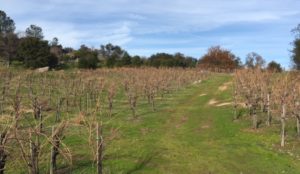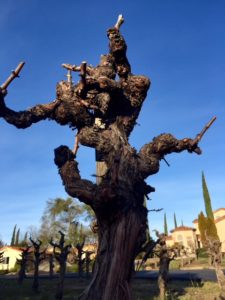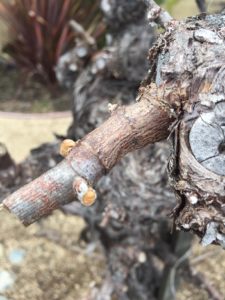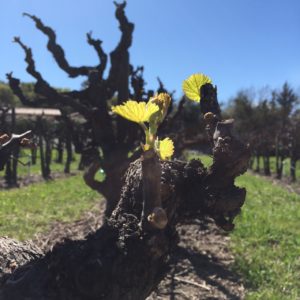Dormant stage
Let’s start the cycle in the dormant stage. After harvest as the weather cools the vines begin to shed their leaves and the once vibrant elastic shoots begin to dry out, harden and become canes. The vines retreat inward to sleep through the winter.
Often times you’ll want to do a winter pruning to clean-up the vineyard and make it easier to work in by trimming back the unruly canes to a more manageable level. You don’t want to go too far otherwise you run the risk of Eutypa or other trunk rot diseases infecting the vines. Because the vines are dormant, they aren’t pushing water and nutrients through their system. Foreign spores can establish themselves in the pruning wounds where they begin to grow. If you do an early winter pruning, you want to leave several inches above where you expect to cut for your final pruning in the February timeframe. Often time people will leave four or five buds in during the winter prune, and then go back an trim to 2 buds in January or February. By doing this you basically trim away any disease or infection that might have made it’s way in to vine through pruning wounds.

Dormant vines after a winter pre-pruning
Pruning
Towards the end of winter it’s time to look at final pruning. This is when you trim back to the number of buds needed to get the number of shoots per cane that you are targeting. You are pruning away the remaining buds and cane, leaving an inch or so of the cane beyond your second fruiting bud. If you’re interested you can check out my post on Learning to Prune, to read all about this aspect of grape farming.

Pruned vine
Pushing water
You’ll sometimes hear the term “pushing water” this occurs when the vines begin to awaken from the dormant stage. You can often see drops of water at the end of a pruned cane. This water isn’t dew or left over rain water, but is in fact, moisture cycling through the grape vine. Typically you’ll see this after pruning and before bud break, around the time that the buds begin to soften and swell.
Bud Break
We typically see bud break or bud burst towards the end of March in Clos du Lac. This is when the buds swell to the point where the shoots and initial leaves sprout from the buds. Note that these infant shoots can crop up other places than the buds you desire to sprout. These spurious shoots should be removed before they become hardier, and more difficult to remove. We aim for either 1 or 2 shoots per cane on an 8 spur vertical cordon.


Swelling bud Bud break
The nascent shoots are at their most fragile. A heavy rainstorm can do significant damage as can grazing deer who are sometimes fond of the tender young shoots.